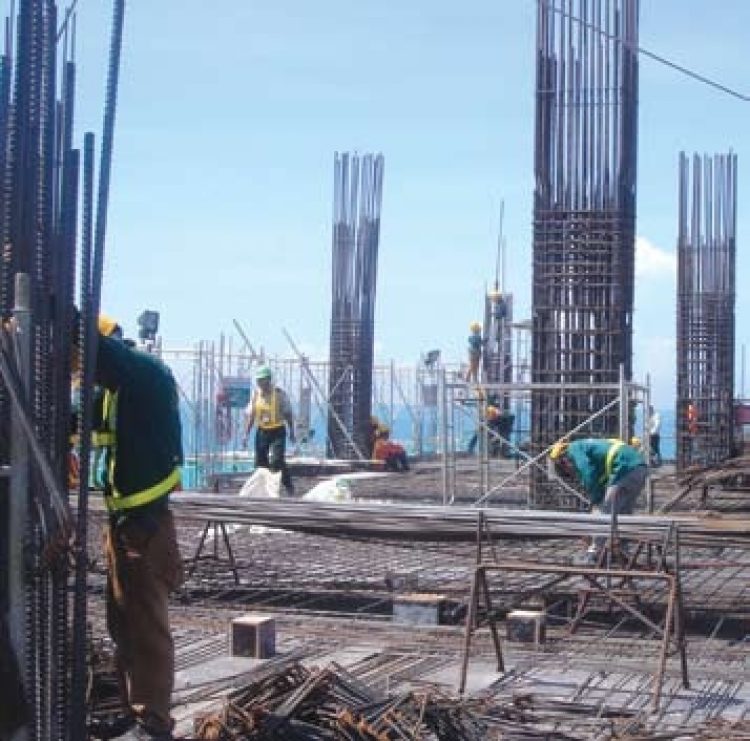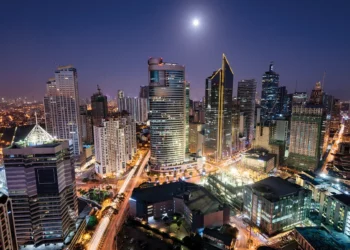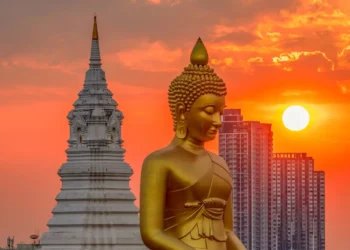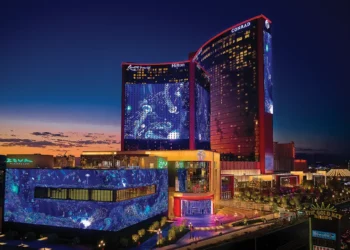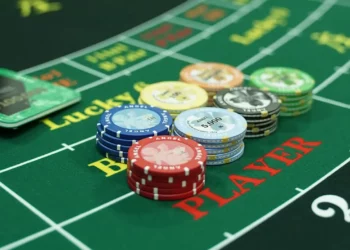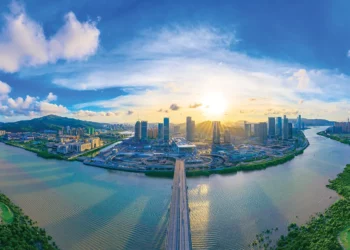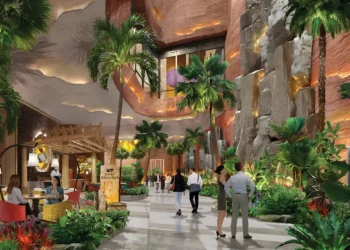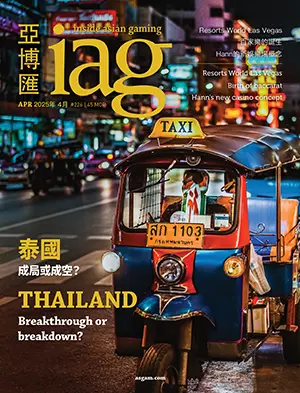Vietnam’s MGM Grand Ho Tram gaming resort has pedigree and first mover advantage on its side
Several Las Vegas casino operators like to claim credit for the invention of the integrated gaming resort concept. What’s beyond doubt is that MGM—in its different corporate incarnations over the years—is a pioneer in putting gambling, entertainment and corporate events all on one site. It did that initially in Las Vegas, but has since exported the model to other markets. It’s also a pioneer in developing networks of such venues and then marketing the network—both within specific national markets and cross-border—in an integrated way. That has helped MGM and the industry as a whole build the revenues of all three business segments within the integrated resorts (gaming, hospitality and MICE), rationalise the costs base of the businesses and smooth the seasonal volatility previously associated with Las Vegas and other gaming resorts as holiday venues.
Now MGM Resorts International—in a branding and management agreement with owner and developer Asian Coast Development (Canada) Ltd—is bringing that principle to a new Asian gaming and entertainment resort. The Ho Tram Strip—a coastal development in the south of Vietnam, is around 120 kilometres from the country’s largest metropolis, Ho Chi Minh City, and its population of over 10 million people. The first of five resorts, branded as MGM Grand Ho Tram, is to be launched in two phases. Phase one, featuring a 13,600 square meter casino with 90 live table games and 500 electronic games, is currently under construction and will open in the first quarter of 2013. That initial stage will also feature the launch of high quality leisure and entertainment products, including the five-star MGM Grand Ho Tram hotel with 541 rooms. The second phase will see a further 500 electronic games added to the casino offer, another 559 hotel rooms and villas, plus a full range of retail, dining and conference facilities. There is also an 18-hole golf course designed by champion golfer Greg Norman.
If any casino operator in the world can make the MGM Grand Ho Tram a success, then it must surely be MGM Resorts. The entertainment and resort part of the offer will be not merely a bolt-on—as happens in some other Asian projects touting‘integrated resort’status—but central to the scheme. When Jim Murren, the Chairman and Chief Executive Officer of MGM Resorts International, visited the Ho Tram site in November, he was in no doubt about its significance for the company—as second only in the Asian region to the company’s joint venture in Macau.
Vietnam is an integral part of our strategic plans for ambitious developments in Asia. We believe the Ho Tram development is perfectly suited to complement Vietnam’s rapid growth in international visitation, expanding domestic tourism, and increasing demand for luxury leisure opportunities,” stated Mr Murren.
On the one hand, the fact that Vietnamese citizens will not be able to use the casino at MGM Grand Ho Tram—unless they’re one of the approximately 3.7 million Vietnamese with access to a foreign passport—could be seen by some potential investors as a downside for the project. On the other hand, Vietnam boasts one of the fastest growth rates in the region for the number of millionaires, according to a report by wealth management company Merrill Lynch and consulting company Capgemini. MGM Resorts’ reputation for creating all-round entertainment venues and feeding them customers via the company’s sophisticated marketing system is likely to be central to guaranteeing MGM Grand Ho Tram’s success.
In other words, MGM Resorts already has extensive experience of operating environments where leisure and entertainment—rather than pure gambling—are the key drivers of revenues.
Inside Asian Gaming spoke to three key executives involved in developing the Ho Tram project for their thoughts on what the market can expect. They are: Gamal Aziz, CEO of MGM Hospitality; Lloyd Nathan, CEO of Asian Coast Development (Canada) Ltd; and John Shigley, President and COO of MGM Grand Ho Tram. Previously, Mr Nathan was President of Global Gaming Development for MGM MIRAGE, the predecessor company to MGM Resorts.
IAG: What’s the significance of the Ho Tram Strip project?
Lloyd Nathan: We are the only licensed integrated resort in Vietnam under construction. We’re now nine storeys out of the ground and it’s a project with the best blue chip partners—from MGM Resorts to Steelman Partners [architects] to Rider Levett Bucknall [project managers and quantity surveyors] and Meinhardt [engineering consultant].
It’s also the only realistic short- to medium-term large-scale gaming opportunity in the Asia region. Macau and Singapore are lock ups for the foreseeable future. Malaysia is a monopoly. Cambodia is in effect a monopoly because NagaCorp has an exclusive casino licence in Phnom Penh and a large radius round it, and while there are numerous border casinos, there are no integrated resorts there. Myanmar and North Korea present insurmountable issues for today. Laos is a very small market, Indonesia has shown minimal desire for gaming and the current political situation in Thailand is unlikely to lend tself to liberalized casino gaming for the foreseeable future.
There are two different viewpoints on whether Japan will liberalise, given the recent and very unfortunate tsunami and earthquake. Some believe it will accelerate the idea of them bringing
casino gaming—Sheldon Adelson is one. And some believe it will decelerate the process and make it less likely—Steve Wynn among them. My views are closer to those of Steve. Given the level of political consensus that would need to exist for there to be liberalised casino gaming, I believe Japan has far more weighty affairs to worry about right now.
South Korea, with 16 foreigner-only casinos and one—Kangwon Land—for domestic gaming, has not indicated any driving appetite to expand domestic gaming outside of Kangwon Land.
In Taiwan, we’ve seen great moves. I think they’re real moves. I think they’ll result in something one day. But if you take a close look at the draft rules, as well as the Offshore Islands Development
Act enabling referendums, it appears the timing is again not in the very near future. The Philippines is a great commercial market—we’d love to be there. One of the challenges there from a regulatory perspective is the current structure whereby PAGCOR is both the regulator and an operator. So the only short- to mediumterm large-scale gaming opportunity in the region is Vietnam. And we have a licence from the government of Vietnam, namely an investment certificate allowing large-scale gaming. And it’s the only one funded, under construction, and rapidly coming out of the ground as we speak.
What can the market expect in terms of the hospitality offer at Ho Tram?
Gamal Aziz: The hospitality offering of MGM was built many, many years ago on the concept of ‘non-traditional’ hospitality. That’s in the sense that it allows you to spend your entire time within the confines of the hotel and never be bored and never be wanting to leave. MGM is traditionally and culturally known in Las Vegas for energy, excitement, fun—MGM venues have always got a buzz about them for one reason or another—it can be a concert, a boxing match. All the amenities we have added over the years have given us a unique view and a unique interest in the hospitality business. It’s actually a testament to the strength of the brand that within the last couple of years— during the most difficult times economically, globally—we’ve been able to sign more than 18 deals around the world, starting with India and all the way to the Middle East.
Vietnam is a very special opportunity that we have. Lloyd and myself have been working on it for many years. Lloyd, being highly engaged with the opportunity and working to bring it to life, brings a unique perspective on what to do in Ho Tram. It’s about differentiating and distinguishing ourself from the rest of the market.
The non-gaming product—what I saw recently with Lloyd and John on a visit—is going to be truly extraordinary. It will shine compared to any product that is in the [Vietnam] market. Add to that the excitement and energy that MGM the brand can bring to the table, from the restaurants to the pool amenities to the music— just that sense of fun that exists throughout the resort will be something that will bring in guests from all over the world to stay.
MGM has positioned Ho Tram on the absolute top priority for our future. We have appointed John Shigley who has worked for our company for many, many years—to lead this opportunity for us in Vietnam.
We’re putting tremendous support behind Ho Tram and as far as the Hospitality division of the company is concerned, this will be our flagship when it comes to gaming. We really are putting all of our resources behind it.
Will Ho Tram become a regional destination for big sporting events? Perhaps big boxing matches such as a Manny Pacquiao fight?
GA: Lloyd, John and myself have talked about making Ho Tram an entertainment destination and entertainment comes in many forms. We’re going to look at every opportunity aside from golf and all the activities associated with golf.
How will the resort look and feel?
John Shigley: It will be not only the most beautiful but also the highest level of service that’s offered in Vietnam and in this particular part of the world. Steelman’s done a fantastic job designing a beautiful product and we intend to bring the level of service to it that people expect from MGM Grand and MGM Hospitality.
We’ll have a lot to offer not only to the gaming customers who come from all over the world, but also the local people here in Vietnam. We’ll offer them a level of entertainment and a quality of service that they haven’t previously experienced here in Vietnam.
Where do you expect your gaming customers to come from given that Vietnamese won’t be allowed to gamble unless they have access to a foreign passport?
JS: I think they’ll come from mainland China, I think they’ll come from Thailand. I think we’ll see that many customers that today are going to Macau will come here for a change. I think you’ll see customers that go to Singapore [casino resorts] come here for a change. I think a lot of people are going to want to come and check it out and find out what MGM Grand Ho Tram is all about.
Will you be able to market to VIP players who are already customers of MGM Macau?
JS: We expect to work closely with MGM Resorts International on how we bring customers here to Ho Tram.
Has ACDL had any assurances from the Vietnamese government on the tax rates for gaming?
LN: The Government of Vietnam is in the process of drafting a Gaming Decree that among other matters will bring clarity to its existing gaming structure, including fiscal. They are a government well versed in the intricacies of gaming, as well as the competitive dynamics in the Asian region, and based on what has happened to date, we are confident there will be an appropriate regulatory and fiscal structure.
One industry practitioner with experience of Vietnam expressed concerns to IAG that gaming tax rates in
Vietnam can change without notice.
LN: In 2003, the then Governor of Illinois decided to double the top gaming tax in his State to 70%, the second hike in two years. It was a bolt out of the blue for many and resulted in people being laid off, casinos having to reduce other costs and customers taking their business out of state. It can happen anywhere but thankfully there are jurisdictions—Nevada and Singapore among them—that understand the wider economic benefits and investment that come from low, stable and predictable tax rates. As I said, the Government of Vietnam understands the issues and has shown consistent thinking.
I have had the privilege of speaking to governments all over the world. I gave evidence before the UK parliament on gaming; I’ve also given evidence to the Japanese diet. And I can say that the Vietnamese government is very, very well versed in the intricacies of gaming. They have gone out of their way to visit several gaming destinations around the world. They’ve met with the Nevada Gaming Commission and other regulators several times. And their approach to date has shown a desire absolutely to create a properly regulated environment; one with the right fiscal structure and which at the same time enables commercial enterprises to thrive.
Does that clarity also apply to corporate tax rates?
LN: Under our investment certificate—which is the governing document of businesses in Vietnam—we have certain tax breaks codified there. So we know up front what breaks we have and are appropriately entitled to. I’ve been involved in this project for four years—three years wearing an MGM hat and one year as the CEO of the company. I’ve not seen the government falter on one representation they’ve made to MGM and/or ACDL.
Has the Vietnamese government confirmed that Ho Tram is part one of a three-part plan for gaming resorts in the country—the other two being at Da Nang on the central coast, and Halong Bay in the north?
LN: I cannot presume to speak on behalf of the Vietnamese government. They will do as they see fit. I will stress again how well versed they are in gaming and how well versed they are in the competitive dynamics around Asia when it comes to fiscal [tax] rates and within their own country. It has been suggested that they are looking to create those three licences. We haven’t seen anything to contradict that.
Da Nang has 750,000 people and very poor ‘airlift’ [flight connections]. Competitively I’m not concerned. And if they do come in, I would suggest it would give extra weight to the push for an
appropriate regulatory environment and everything that comes with it. The project in the north I don’t have a comment on because my understanding is that’s not out of the gate.
We are 120 kilometres from a metropolis of over 10 million people [Ho Chi Minh City] and we have significant airlift with a new airport coming online.
If sports betting is legalised for Vietnamese citizens as proposed, would you be able to offer it on site to your local guests?
LN: The current sports betting decree that is going through a consultative process calls for sports betting on a limited number of events including some European soccer, and in limited venues around Vietnam and for a limited amount [of stake money]—US$50 a day. We see it as a very interesting development because obviously it legalises and regulates something that has likely been going on underground and illegally. At Asian Coast Development Ltd we would welcome with open arms the ability
to have sports betting on our site. But I think it’s going to be a step by step process, and I don’t think that we, sitting here today, can guarantee we will have that.
How would you summarise your feelings about this project?
GA: We’re incredibly proud and honoured to be part of this project and to put our brand on the MGM Grand Ho Tram. We’ve been visiting the site quite often and seeing the incredible team that’s been built.
Our employees over the years have found MGM the best place to work in the industry and our Vietnamese employees will find the same open arms in MGM Grand Ho Tram. I think it’s going to be an extraordinary success when we open in the first quarter of 2013.
JS: We’ll have a lot to offer not only to the gaming customers who come from all over the world, but also the local people here in Vietnam. We’ll offer them a level of entertainment and a quality of service that they haven’t previously experienced here in Vietnam. We’re also working with local schools on the staff recruiting and internship aspects of the business and working with a lot of local vendors and providers of tourist services. When they see the MGM card and logo, people’s eyes light up. It really creates a buzz.
LN: Vietnam is a country where 65% of the population are under the age of 35. When you talk about ‘being in the right place at the right time,’ that applies absolutely to Vietnam. Demographically, there’s an expansion of people with more and more disposable income, and people who want to spend that income—and that doesn’t have to be on the gaming, but on the non-gaming amenities that we will create.
We’re on schedule to open our first resort in Q1 2013. We’re working on level nine of the high rise. The clout of MGM both in terms of marketing and reach should not be underestimated. They’ve been doing business in Asia for 30 years. They have a huge marketing organisation around the world. And what Gamal has achieved with the Hospitality division in such a short space of time is nothing short of miraculous. He has planted flags with the MGM brand all over the world and it’s clearly going to be of great advantage to us here at Asian Coast Development Ltd. To have the operator of our first resort having all these different marketing channels—including their hotels around the world; some of them in mainland China—is going to help bring people to our resort. Finally, the selection of John—such a highly talented veteran executive—as president of the property is also a testament to MGM’s commitment to the project.






